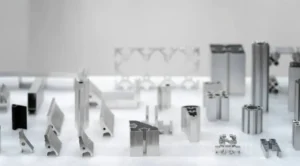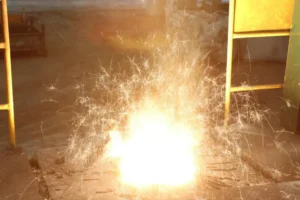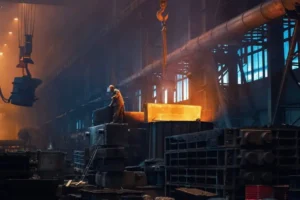Target Industry: Wind Power (specifically large castings like hubs, bedplates, and bearing housings).
Focus: Challenges in Composition and Temperature Control for Large Capacity (>20 طن) Induction Furnaces during Melting, Nodularization, and Long-term Holding.
In this operating scenario, the three core characteristics are “Heavy Section, Long Duration, and High Purity.” The challenges faced here differ significantly from those in standard small-to-medium casting production.
أنا. Melting Phase: Controlling “التوحيد” و “Heredity” in Large Capacities
For furnaces larger than 20 طن, melting is not just about liquefying iron; it is critical for eliminating raw material heredity and ensuring metallurgical purity.
1. Temperature Control Challenges: Vertical Gradients & كفاءة
- Large Vertical Temperature Gradient: Deep furnace bodies in large tonnage units can lead to thermal stratification if the inductor design or power density is mismatched. You may encounter the “top cold, bottom hot” phenomenon, where the molten iron at the bottom is overheated (causing carbon loss and dissolution of nucleation sites), while the charge at the top is not yet fully melted.
- Measurement Lag: في 20 tons of molten iron, single-point thermocouple measurement lacks representation. If electromagnetic stirring is insufficient, the time required for thermal homogenization increases, leading to oxidative drift of C and Si during this period.
2. Composition Control Challenges: Trace Element Accumulation & C-Si Balance
- Interference from Scrap Dependence: Wind power ductile iron (على سبيل المثال, QT400-18AL) demands extremely high low-temperature impact toughness. Large furnaces often utilize a “Synthetic Cast Iron” process with high scrap ratios. A 20-ton volume implies multiple batches of raw materials, making it difficult to control trace elements that destroy nodularity or the matrix (like Pb, ل, As).
- Unstable Carbon Absorption: In large-capacity synthetic processes, the absorption rate of recarburizers is heavily influenced by temperature and agitation intensity. If a large furnace is operated at full capacity, the turbulence at the liquid surface is limited. Recarburizers can get wrapped in slag, leading to fluctuations in the final Carbon Equivalent (CE), which directly affects graphite flotation or shrinkage tendencies.
الثاني. Nodularization (Spheroidization): Balancing “Fading” و “Eruption”
This is the most critical risk point in wind power casting production. Large treatment volumes mean violent reactions, but also imply long pouring times, facing severe fading risks.
1. Temperature Control Challenges: Extremely Narrow Process Window
- The Dilemma of Treatment Temperature:
- Too High (>1500°C): The reaction in 20 tons of iron is violent. المغنيسيوم (ملغ) vaporizes instantly, leading to extremely low and unstable recovery rates, blinding magnesium flare, and environmental smoke issues.
- Too Low: The pouring system for heavy section castings is massive, resulting in long filling times. If the treatment temperature is too low, the iron temperature may drop below the liquidus line near the end of pouring, causing poor fluidity, cold shuts, or slag inclusions.
- Thermal Drop Estimation Deviation: Although a large ladle has high thermal mass, the time required for ladle transfer, slag skimming, and hoisting to the pouring station is much longer than for small parts. Precisely controlling the final pouring temperature (usually 1330°C–1350°C) requires an accurate model of “Tap Temperature vs. Lining Heat Loss vs. Time.”
2. Composition Control Challenges: Fading & Chunky Graphite
- المغنيسيوم “Long-term Fading”: For >20t iron, the time from the end of nodularization to the end of pouring can span 20–40 minutes. Residual Mg continuously oxidizes and fades. If you add excess Mg initially to guarantee the tail end, the front end may suffer from shrinkage porosity أو كربيدات; if you add too little, the tail end suffers from low nodularity.
- “Chunky Graphite” in Heavy Sections: This is a nightmare for wind power castings with wall thicknesses >200mm. To combat fading in large batches, higher Rare Earth (RE) content is often used. لكن, in thick sections with slow cooling, RE segregation leads to chunky graphite, causing a drastic drop in mechanical properties. Controlling the Mg/RE ratio at a micro-level (and using trace elements like Sb or Bi) is a major difficulty in large furnace control.
ثالثا. Long-term Holding: ال “Nucleation Death” Issue
Manufacturing super-large wind power castings (على سبيل المثال, >50t hubs) often requires “Multi-Furnace Combined Pouring” (على سبيل المثال, three 20t furnaces supplying iron simultaneously). This means the first batch of melted iron may need to be held for a long time while waiting for subsequent batches.
1. Composition Drift: Carbon Loss & Dead Iron
- “Dead Iron” Phenomenon: During long-term electrical holding (especially >1 hour), the iron is under electromagnetic stirring. Heterogeneous nucleation sites (oxides, sulfides) aggregate and float out or decompose. The iron becomes very “ينظف” but loses its crystallization nuclei. Even with subsequent inoculation, this iron is prone to high chill tendencies (كربيدات) and low nodule counts.
- C/Si Changes: prolonged high-temperature holding causes continuous carbon oxidation. Conversely, if the lining is acidic (رمال السيليكا), Silicon may increase due to the reduction reaction ($SiO_2 + 2C = Si + 2CO$), disrupting the planned Carbon Equivalent.
2. تآكل البطانة & Cleanliness
- Lining Reaction: High-power holding intensifies the reaction between the lining and slag. Long durations can cause slag to change properties (from acidic to basic or vice versa), altering its ability to adsorb inclusions, or even reducing unwanted elements (like Al, ل) back into the melt.
ملخص: Core Control Parameter Comparison
| Process Step | Common Issue | Unique Difficulty (>20t) | Risk for Wind Power Castings |
| ذوبان | Inaccurate Composition | Temp/Composition stratification; Fluctuation in recarburizer absorption | Low-temp impact toughness failure; Insufficient Ferrite content |
| Nodularization | Eruption / Fading | Mg recovery is unpredictable; Long transport time causes severe fading | Chunky graphite in thick walls; Low nodularity in casting body |
| عقد | Nuclei Dissolution | Iron becomes “Overheated/Dead”; Total loss of nucleation capability | Low nodule count; Severe grain boundary segregation; Shrinkage porosity |







